Food Encapsulation Market Size and Share
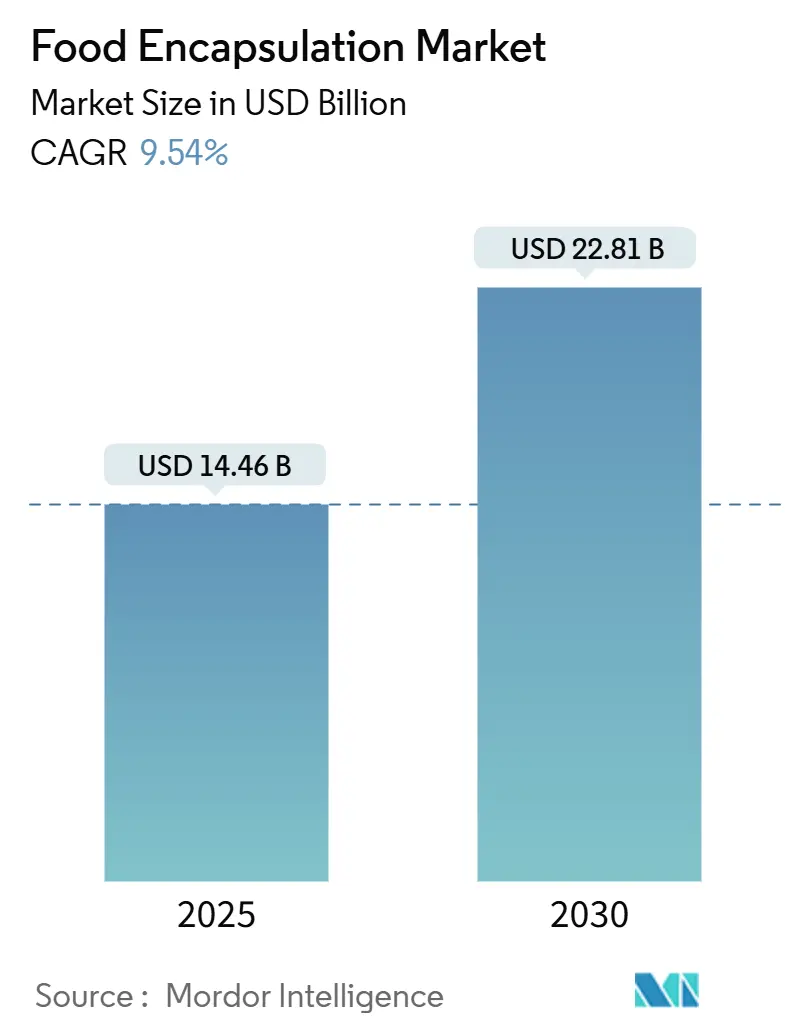
Food Encapsulation Market Analysis by Mordor Intelligence
The food encapsulation market size stands at USD 14.46 billion in 2025, projected to reach USD 22.81 billion by 2030 with a robust 9.54% CAGR. The market growth is driven by increasing consumer demand for functional foods, regulatory requirements for clean-label formulations, and advancements in delivery systems. The market expansion responds to requirements for protecting bioactive compounds during processing, extending product shelf life, and masking unwanted flavors of nutritional ingredients. The rising adoption of microencapsulation techniques in the food industry enables manufacturers to enhance product stability and bioavailability. These technologies protect ingredients from oxidation, moisture, and temperature variations while maintaining their nutritional properties. The dairy and bakery sectors are significant users of encapsulation technologies, particularly for probiotics and omega-3 fatty acids. Additionally, the beverage industry increasingly utilizes these technologies for flavor retention and controlled release of functional ingredients. Emerging technologies like electrospinning and nanoencapsulation are gaining traction for their precision and efficiency. The market also sees growing demand for plant-based coating materials and sustainable encapsulation processes, aligning with environmental concerns and clean-label trends.
Key Report Takeaways
• By technology, microencapsulation held a 50.36% food encapsulation technologies market share in 2024, and hybrid systems are projected to expand at a 12.70% CAGR from 2025-2030.
• By material type, polysaccharides led with 40.27% share in 2024, while protein-based walls are set to grow at 12.94% CAGR through 2030.
• By core phase, vitamins accounted for 27.70% of the food encapsulation technologies market size in 2024; probiotics is expected to register the fastest 11.95% CAGR to 2030.
• By application, foods and beverages dominated with 67.15% revenue share in 2024; dietary supplements rise at a 13.41% CAGR over the forecast period.
• By region, North America commanded 34.59% share in 2024, whereas Asia-Pacific is forecast to post a 12.78% CAGR to 2030.
Global Food Encapsulation Market Trends and Insights
Drivers Impact Analysis
| Driver | (~) % Impact on CAGR Forecast | Geographic Relevance | Impact Timeline |
|---|---|---|---|
| Rising demand for controlled release and improved stability of active ingredients during food processing | +2.1% | Global, with concentration in North America & Europe | Medium term (2-4 years) |
| Increasing demand for functional foods and dietary-supplement fortification | +2.8% | Global, led by Asia-Pacific and North America | Long term (≥ 4 years) |
| Growing adoption of encapsulation technologies to extend product shelf life and preserve ingredient efficacy | +1.9% | Global, particularly emerging markets | Medium term (2-4 years) |
| Increasing use of encapsulation in masking unpleasant flavors and odors of active ingredients | +1.4% | Global, with emphasis on dietary supplements sector | Short term (≤ 2 years) |
| Expanding use of encapsulation for targeted nutrient delivery in personalized nutrition and medical foods | +2.2% | North America & Europe, expanding to Asia-Pacific | Long term (≥ 4 years) |
| Technological advancements in encapsulation techniques | +1.8% | Global, led by developed markets | Medium term (2-4 years) |
| Source: Mordor Intelligence | |||
Rising demand for controlled release and improved stability of active ingredients during food processing
The imperative for controlled release systems has intensified as food manufacturers grapple with increasingly complex processing environments that can degrade sensitive nutrients. Advanced encapsulation techniques now enable precise timing of ingredient release, with some systems achieving 95% retention of bioactive compounds during thermal processing compared to 60% for unencapsulated ingredients. Single-cell encapsulation technologies, termed "Armor Probiotics," represent a paradigm shift by providing individual cellular protection rather than bulk encapsulation, dramatically improving survival rates in harsh processing conditions. The technology proves particularly valuable in high-temperature applications where traditional encapsulation fails, enabling manufacturers to fortify products previously incompatible with heat-sensitive nutrients. This precision approach reduces ingredient waste by up to 40% while ensuring consistent bioavailability across different processing methods. The trend toward personalized nutrition amplifies demand for controlled release systems that can deliver specific nutrients at predetermined rates throughout digestion.
Increasing demand for functional foods and dietary-supplement fortification
Consumer health consciousness has evolved beyond basic nutrition to targeted wellness outcomes, driving unprecedented demand for fortified products that deliver measurable health benefits. Regulatory bodies increasingly recognize encapsulated nutrients as superior delivery mechanisms. The growing application of encapsulation in dietary supplements reflects consumers' willingness to pay premium prices for enhanced bioavailability and targeted delivery. Encapsulation enables the combination of previously incompatible ingredients in single formulations, creating synergistic effects that amplify health benefits. This trend particularly benefits the aging population seeking convenient, effective nutritional interventions for age-related health concerns.
Growing adoption of encapsulation technologies to extend product shelf life and preserve ingredient efficacy
Supply chain disruptions and sustainability concerns have elevated shelf life extension from a convenience feature to a business imperative, with encapsulation technologies offering solutions that reduce food waste while maintaining nutritional integrity. Recent innovations in bacterial nanocellulose encapsulation demonstrate remarkable thermal stability improvements, with vitamin B complex degradation temperatures increasing from 207°C to 340°C for B1 and similar enhancements across other vitamins. Smart packaging integration with encapsulated ingredients creates active preservation systems that respond to environmental changes, extending fresh produce shelf life compared to traditional packaging. The technology proves especially valuable in emerging markets where cold chain infrastructure remains limited, enabling broader distribution of nutritious products. Manufacturers increasingly view encapsulation as insurance against supply chain volatility, with protected ingredients maintaining potency even under suboptimal storage conditions. The convergence of encapsulation with IoT sensors creates predictive preservation systems that optimize release timing based on real-time environmental data.
Technological advancements in encapsulation techniques
The encapsulation field experiences rapid innovation as traditional boundaries between nano and microencapsulation blur, giving rise to hybrid systems that optimize protection and release characteristics for specific applications. Electrospinning techniques now achieve encapsulation efficiencies exceeding 97% while maintaining probiotic viability under extreme thermal stress, with gelatin-dextran nanofibers protecting Lactobacillus plantarum at temperatures up to 72°C. Protein-polysaccharide conjugation represents another breakthrough, with rice protein-inulin complexes demonstrating 96.99% encapsulation efficiency and superior gastrointestinal survival compared to native proteins. Machine learning algorithms now optimize encapsulation parameters in real-time, reducing development cycles from months to weeks while improving consistency. The integration of natural biopolymers with synthetic materials creates biodegradable encapsulation systems that address environmental concerns while maintaining performance. These technological leaps enable previously impossible applications, such as encapsulating volatile compounds that require precise release timing during mastication.
Restraints Impact Analysis
| Restraint | (~) % Impact on CAGR Forecast | Geographic Relevance | Impact Timeline |
|---|---|---|---|
| High capital and processing costs | -1.8% | Global, particularly impacting smaller manufacturers | Short term (≤ 2 years) |
| Storage and shelf-life limitations of encapsulated ingredients | -1.2% | Global, with greater impact in tropical regions | Medium term (2-4 years) |
| Raw material cost fluctuations | -1.1% | Global, with acute impact in emerging markets | Short term (≤ 2 years) |
| Thermal and mechanical instability of encapsulated ingredients during advanced food processing methods | -0.9% | Global, concentrated in high-temperature processing sectors | Medium term (2-4 years) |
| Source: Mordor Intelligence | |||
High capital and processing costs
The substantial capital requirements for advanced encapsulation equipment create significant barriers to entry, particularly for smaller manufacturers seeking to compete with established players who benefit from economies of scale. Spray-drying systems capable of producing consistent microencapsules require high investments. Raw material costs compound the challenge, with specialized wall materials like modified proteins commanding premium prices that can increase ingredient costs by 200-400% compared to conventional alternatives. The complexity of process optimization requires specialized expertise that commands high salaries, further inflating operational costs. Energy-intensive processes like freeze-drying for sensitive probiotics can increase production costs by 50-80% compared to conventional preservation methods. These cost pressures force manufacturers to focus on high-margin applications, limiting the technology's penetration into mass-market products where price sensitivity remains paramount.
Storage and shelf-life limitations of encapsulated ingredients
Despite protection benefits, encapsulated ingredients often exhibit shorter shelf lives than anticipated, creating inventory management challenges and limiting product development flexibility for manufacturers. Moisture sensitivity remains a critical vulnerability, with many encapsulated probiotics losing viability within 6-12 months under typical storage conditions, compared to 24-36 months for freeze-dried alternatives. Temperature fluctuations during transportation and storage can compromise capsule integrity, leading to premature release and ingredient degradation that undermines the encapsulation investment. The requirement for specialized storage conditions increases supply chain complexity and costs, particularly problematic for global distribution networks. Quality control becomes more challenging as encapsulated ingredients require sophisticated analytical methods to verify integrity and potency throughout their lifecycle. These limitations force manufacturers to maintain larger safety stocks and implement more frequent quality testing, increasing working capital requirements and operational complexity.
Segment Analysis
By Technology: Hybrid Systems Drive Innovation
Hybrid encapsulation technologies grow at 12.70% CAGR through 2030, while microencapsulation holds 50.36% market share in 2024, indicating a market shift toward advanced multi-layer protection systems. This trend emerges as manufacturers recognize the limitations of single-technology approaches in meeting the stability and release requirements of functional ingredients. Microencapsulation maintains market leadership through its established reliability and cost-effectiveness, particularly in vitamin and mineral fortification applications. Nanoencapsulation advances in premium segments requiring improved bioavailability, with lipid-based systems demonstrating effectiveness for fat-soluble compounds.
Hybrid technologies gain prominence by combining nanoencapsulation's quick release properties with microencapsulation's protective features, enabling customized delivery profiles. Patent applications show technical advancement in multi-layer systems, incorporating pH-responsive elements and time-release mechanisms designed for specific digestive conditions. These systems prove essential in probiotic applications, providing protection during manufacturing and controlled release in the intestinal environment. While current costs restrict hybrid systems to high-value products, ongoing improvements in manufacturing efficiency indicate wider adoption as equipment expenses decrease.
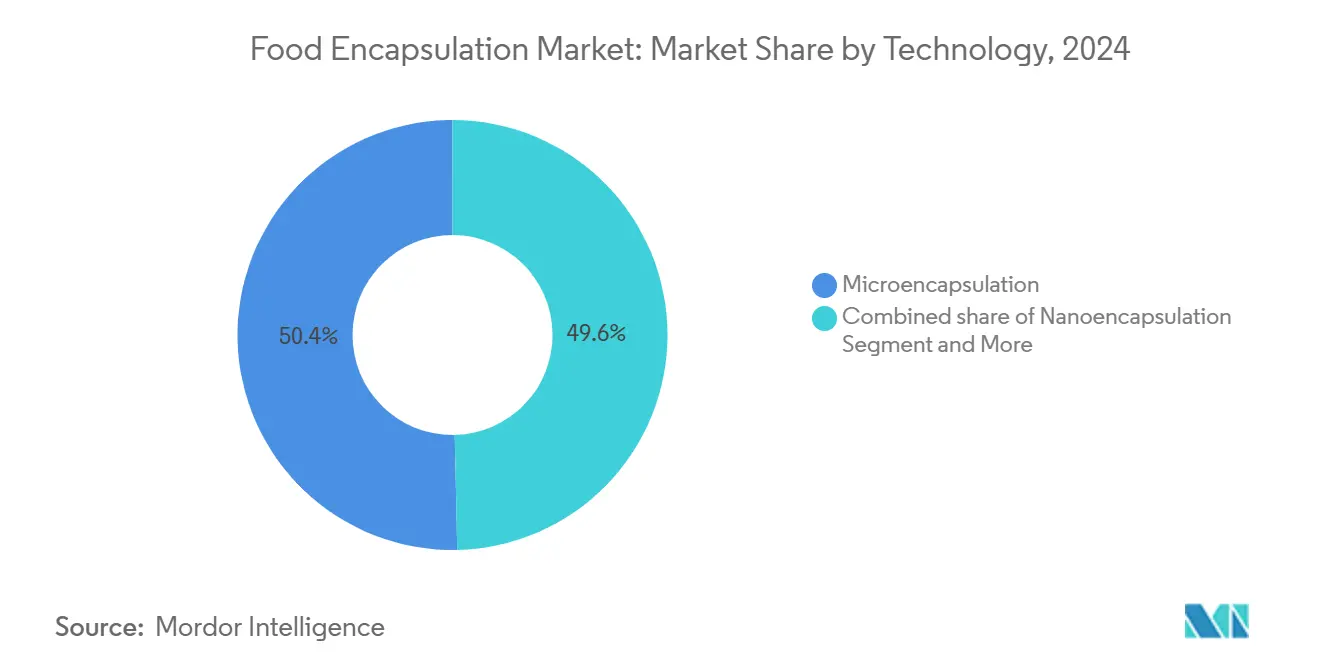
Note: Segment shares of all individual segments available upon report purchase
By Material Type: Protein Innovation Accelerates
Protein-based encapsulation materials are growing at 12.94% CAGR through 2030, while polysaccharides hold 40.27% market share in 2024, driven by clean-label demands and superior functional properties for specific applications. This acceleration reflects the food industry's broader shift toward recognizable, naturally-derived ingredients that resonate with health-conscious consumers. Polysaccharides retain their leadership through versatility and cost-effectiveness, with alginate and chitosan particularly valued for their film-forming properties and biocompatibility. Lipids serve specialized roles in moisture barrier applications, while emulsifiers enable complex formulations requiring stability across diverse pH and temperature conditions.
The protein segment's rapid growth stems from recent breakthroughs in modification techniques that enhance solubility and encapsulation efficiency, with enzyme-modified proteins achieving encapsulation rates exceeding 96% [1]Frontiers in Sustainable Food Systems, “Protein–Polysaccharide Conjugation for Probiotic Delivery,” frontiersin.org. Whey protein complexes with polysaccharides demonstrate superior thermal stability, maintaining probiotic viability at temperatures up to 72°C compared to 55°C for unmodified proteins. Plant-based proteins gain momentum as manufacturers seek allergen-free alternatives, with pea and rice proteins showing comparable performance to dairy-derived options. The regulatory environment increasingly favors protein-based systems as GRAS-approved materials, accelerating their adoption in novel food applications. Other shell materials, including synthetic polymers and hybrid composites, occupy niche roles where specific performance characteristics justify their higher costs.
By Core Phase: Probiotics Lead Growth Revolution
The probiotics segment is projected to grow at a CAGR of 11.95% through 2030, while vitamins hold a 27.70% market share in 2024. The rapid growth of probiotics reflects increasing consumer awareness of gut health benefits and their role in functional foods. Scientific research supporting the connection between gut microbiome health and overall wellness drives this expansion. Vitamins maintain market leadership due to their proven effectiveness and regulatory compliance, especially in fortification applications where enhanced bioavailability supports encapsulation investments.
Single-cell encapsulation technologies revolutionize probiotic delivery by providing individual cellular protection rather than bulk encapsulation, dramatically improving survival rates during processing and storage. Prebiotics increasingly complement probiotic formulations, creating synbiotic systems that enhance overall efficacy. Other core materials, including peptides and botanical extracts, expand as personalized nutrition drives demand for targeted bioactive delivery.
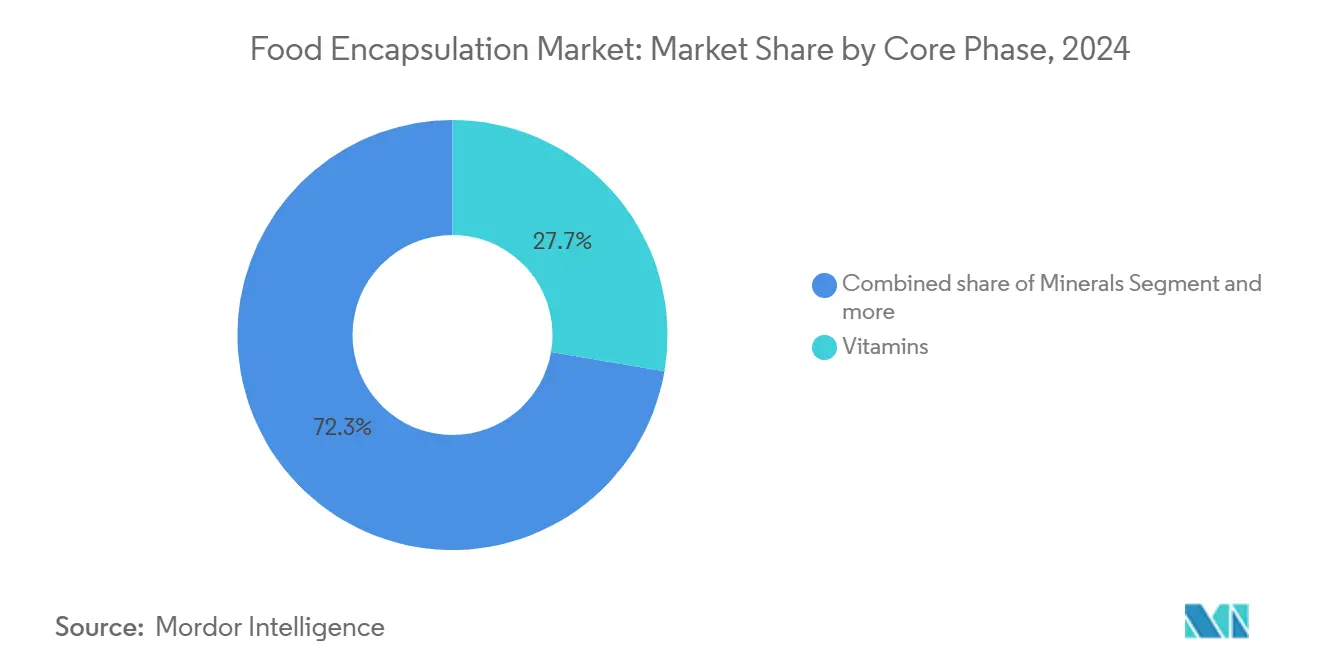
Note: Segment shares of all individual segments available upon report purchase
By Application: Dietary Supplements Surge Ahead
The dietary supplements segment is projected to grow at a CAGR of 13.41% through 2030, while foods and beverages hold 67.15% of the market share in 2024. Consumers demonstrate increased acceptance of premium pricing for supplements offering targeted health benefits and enhanced bioavailability. The supplement industry justifies encapsulation costs through improved efficacy and consumer education. Foods and beverages maintain market leadership through widespread applications in fortification and functional food development, enabling new nutrient combinations through encapsulation technology.
The dietary supplements market expansion is driven by clear regulations for encapsulated ingredients and increased consumer understanding of bioavailability benefits. Innovations in softgel technology, including carrageenan and pectin-based plant alternatives, meet clean-label requirements while maintaining product effectiveness. In the foods and beverages segment, encapsulation technology masks ingredient flavors, increasing consumer acceptance of fortified products. Bakery and confectionery applications show high adoption rates due to processing requirements for ingredient protection, while processed meat alternatives use encapsulation for texture and flavor improvements.
Geography Analysis
North America holds 34.59% market share in 2024, supported by its robust regulatory framework and consumer acceptance of premium-priced functional foods. The region's dominance is based on well-established food innovation infrastructure and widespread adoption of encapsulation technologies by major food manufacturers. The FDA's clear guidelines on encapsulated ingredients encourage manufacturer investment in product development, while consumer understanding of bioavailability benefits supports higher pricing. The FDA's decision to eliminate PFAS in food contact materials creates new opportunities for bio-based encapsulation systems [2]U.S. Food and Drug Administration (FDA), "FDA Determines Authorization for 35 Food Contact Notifications Related to PFAS Are No Longer Effective," fda.gov. The region's strong dietary supplement market, where encapsulation yields high margins, maintains its market position despite lower growth rates.
Asia-Pacific demonstrates the fastest growth at 12.78% CAGR through 2030. Increasing disposable incomes and health awareness drive demand for premium functional foods, while urban expansion creates preservation challenges that encapsulation addresses through improved shelf life. China's regulations now support more encapsulated ingredients, allowing functional delivery through various formats, including candies, beverages, and chocolates. India and Japan contribute through their combination of traditional medicine with modern food technology, developing new applications for encapsulated herbal ingredients. The region's lower manufacturing costs enable wider implementation of encapsulation technologies in mainstream products.
Europe shows consistent growth through strict quality requirements and increased adoption of novel food regulations favoring encapsulated ingredients. EFSA's new guidance, effective February 2025, simplifies approval processes for innovative delivery systems [3]European Food Safety Authority, "Navigating Novel Foods," efsa.europa.eu. The region's focus on clean-label products increases demand for natural encapsulation materials, especially protein-based systems. Germany and the United Kingdom lead in adoption through their developed food processing sectors, while Mediterranean countries specialize in encapsulating traditional ingredients like olive oil compounds. The aging European population sustains demand for nutritional products using encapsulation for targeted delivery. UK manufacturers have increased encapsulation adoption to address Brexit-related supply chain changes.
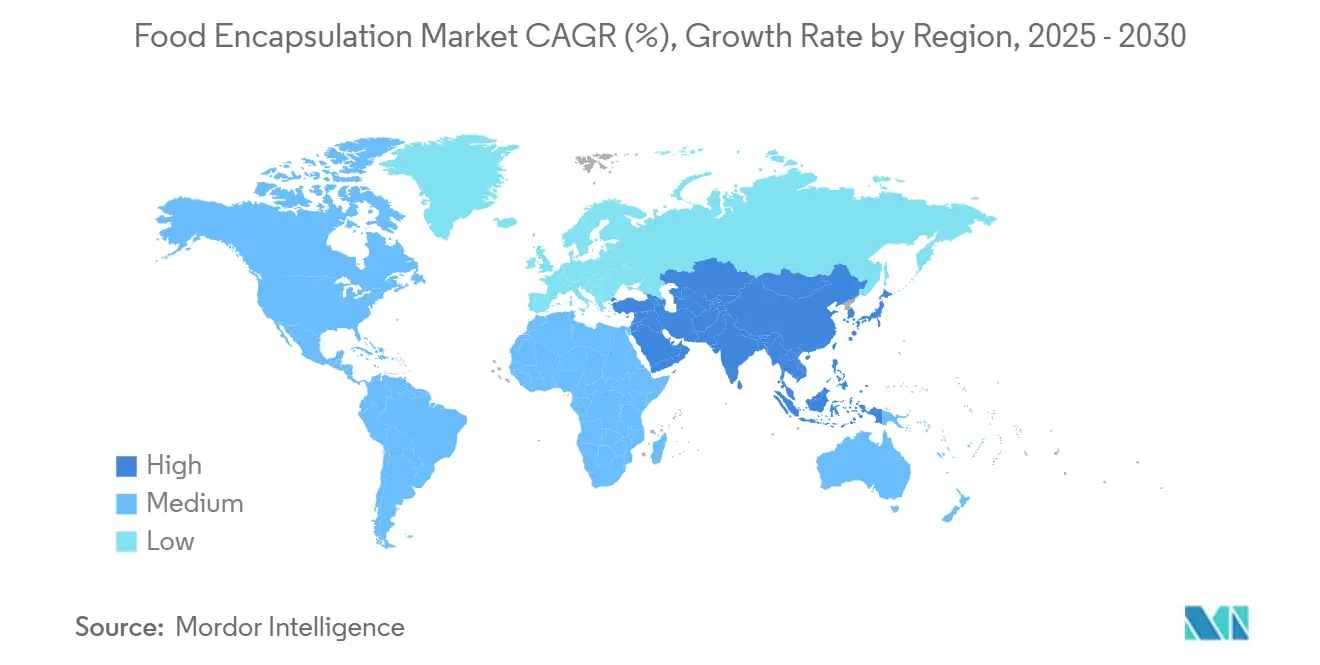
Note: Regional shares of all individual regions will be available upon report purchase
Competitive Landscape
The food encapsulation market demonstrates moderate fragmentation. Established ingredient suppliers are acquiring specialized encapsulation capabilities to provide integrated solutions with higher margins. This strategic move enables these suppliers to cater to the growing demand for advanced and customized ingredient delivery systems across various industries, including food, pharmaceuticals, and cosmetics. The market structure enables both large-scale manufacturers and niche players to coexist, fostering innovation and specialized product development. This coexistence drives competition and encourages the continuous evolution of encapsulation technologies to meet diverse consumer needs.
Key market players include BASF SE, Cargill Incorporated, Kerry Group plc, Royal FrieslandCampina N.V., and Ingredion Incorporated. These companies maintain their competitive positions through extensive distribution networks, diverse product portfolios, and strategic partnerships. Companies' market positions are increasingly determined by their technological capabilities, with significant investments in proprietary encapsulation platforms that enhance protection and release properties.
Patent activities focus on hybrid encapsulation systems and new wall materials, particularly multi-layer approaches that integrate multiple encapsulation technologies for enhanced performance. Market leaders are strengthening their research and development capabilities to develop innovative solutions, while also pursuing strategic acquisitions to expand their technological expertise and geographical presence.
Food Encapsulation Industry Leaders
-
BASF SE
-
Cargill, Incorporated
-
Kerry Group plc
-
Royal FrieslandCampina N.V.
-
Ingredion Incorporated
- *Disclaimer: Major Players sorted in no particular order
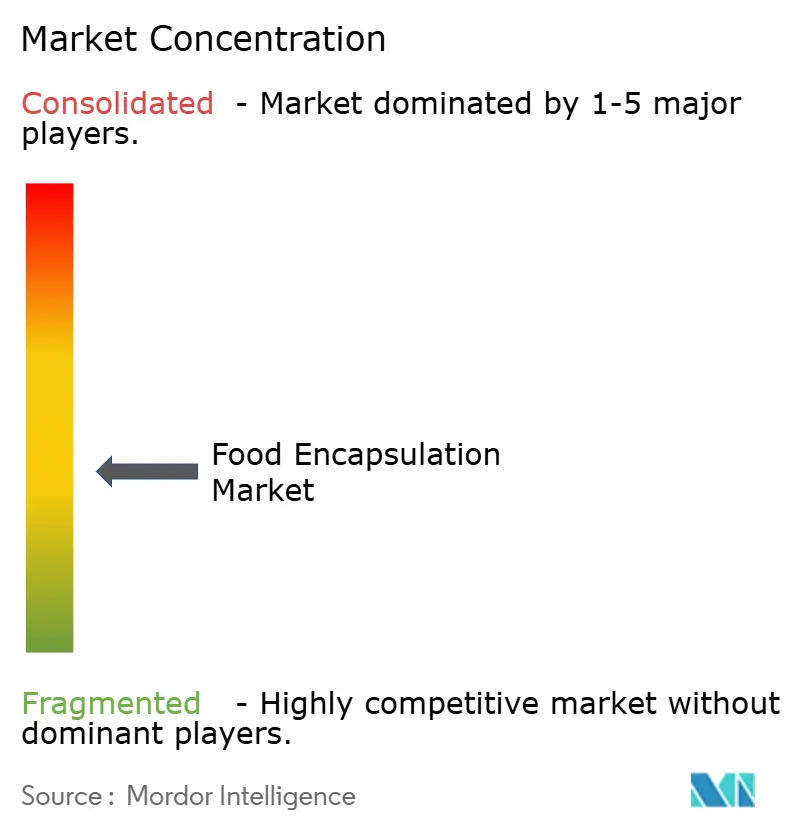
Recent Industry Developments
- May 2025: OOO Component-Lactis, a biotechnology research and production company in Buguruslan, has secured a licensing agreement with the Russian Academy of Sciences (RAS) to produce advanced probiotic products. The company is developing Florobiom, a probiotic formulation for gut microbiota restoration. The product is in the state registration phase, and the company aims to produce one million capsules monthly by the end of 2025. Component-Lactis has implemented RAS technology for microbial biomass encapsulation in its manufacturing process. This development aligns with the company's focus on scientific advancement in production and its goal to decrease dependence on imported health supplements.
- June 2024: Big Idea Ventures (BIV), a global investment firm in food technology, agricultural technology, and materials science, has launched BioCloak, Inc. through its Generation Food Rural Partners (GFRP) Fund. BioCloak focuses on developing and commercializing bio-based encapsulation technologies that reduce microplastics while protecting and enhancing the performance of active ingredients, nutrients, and biologicals in agriculture and animal nutrition applications.
Global Food Encapsulation Market Report Scope
The global food encapsulation market is segmented by technology, material type, core phase. Based on technology, the market is segmented into microencapsulation, nanoencapsulation, hybrid technologies. On the basis of material type, the market is segmented into polysaccharides, proteins, lipids, emulsifiers, other shell materials. On the basis of the core phase, the market is segmented into vitamins, minerals, enzymes, organic acids, additives, probiotics, prebiotics, essential oils, other core phase materials. On the basis of geography, the study provides an analysis of the food encapsulation market in the emerging and established markets across the globe, including North America, Europe, Asia-Pacific, South America, and Middle East & Africa.
| Microencapsulation |
| Nanoencapsulation |
| Hybrid Technologies |
| Polysaccharides |
| Proteins |
| Lipids |
| Emulsifiers |
| Other Shell Materials |
| Vitamins |
| Minerals |
| Enzymes |
| Organic Acids |
| Additives |
| Probiotics |
| Prebiotics |
| Essential Oils |
| Other Core Materials |
| Foods and Beverages | Bakery and Confectionery |
| Snacks Products | |
| Processed Meat, Seafood and Meat Alternatives | |
| Other Food and Beverages | |
| Dietary Supplements | |
| Animal Feed and Pet Nutrition | |
| Other Applications |
| North America | United States |
| Canada | |
| Mexico | |
| Rest of North America | |
| Europe | Germany |
| United Kingdom | |
| Italy | |
| France | |
| Spain | |
| Netherlands | |
| Rest of Europe | |
| Asia-Pacific | China |
| India | |
| Japan | |
| Australia | |
| Rest of Asia-Pacific | |
| South America | Brazil |
| Argentina | |
| Rest of South America | |
| Middle East and Africa | South Africa |
| Saudi Arabia | |
| Rest of Middle East and Africa |
| By Technology | Microencapsulation | |
| Nanoencapsulation | ||
| Hybrid Technologies | ||
| By Material Type | Polysaccharides | |
| Proteins | ||
| Lipids | ||
| Emulsifiers | ||
| Other Shell Materials | ||
| By Core Phase | Vitamins | |
| Minerals | ||
| Enzymes | ||
| Organic Acids | ||
| Additives | ||
| Probiotics | ||
| Prebiotics | ||
| Essential Oils | ||
| Other Core Materials | ||
| By Application | Foods and Beverages | Bakery and Confectionery |
| Snacks Products | ||
| Processed Meat, Seafood and Meat Alternatives | ||
| Other Food and Beverages | ||
| Dietary Supplements | ||
| Animal Feed and Pet Nutrition | ||
| Other Applications | ||
| By Geography | North America | United States |
| Canada | ||
| Mexico | ||
| Rest of North America | ||
| Europe | Germany | |
| United Kingdom | ||
| Italy | ||
| France | ||
| Spain | ||
| Netherlands | ||
| Rest of Europe | ||
| Asia-Pacific | China | |
| India | ||
| Japan | ||
| Australia | ||
| Rest of Asia-Pacific | ||
| South America | Brazil | |
| Argentina | ||
| Rest of South America | ||
| Middle East and Africa | South Africa | |
| Saudi Arabia | ||
| Rest of Middle East and Africa | ||
Key Questions Answered in the Report
What is the projected size of the food encapsulation technologies market by 2030?
The food encapsulation technologies market size is forecast to reach USD 22.81 billion by 2030, growing at a 9.54% CAGR from 2025.
Which technology segment is expected to grow the fastest?
Hybrid encapsulation systems are set to expand at a 12.70% CAGR as their multilayer designs combine nano- and micro-scale benefits.
Why is Asia-Pacific considered the key growth engine?
Double-digit functional-food demand, supportive regulations and cost-efficient manufacturing hubs drive a 12.78% CAGR in Asia-Pacific.
Which core phase shows the highest growth potential?
Probiotics lead growth with an 11.95% CAGR, supported by advanced single-cell encapsulation techniques that enhance shelf life and digestion-targeted release.
Page last updated on:



